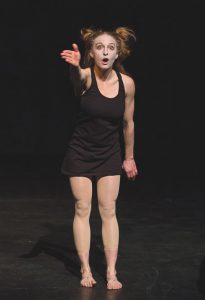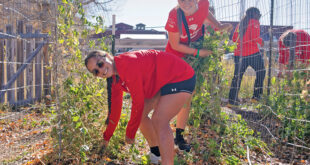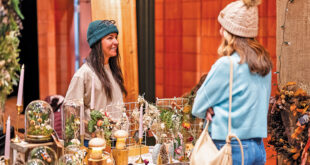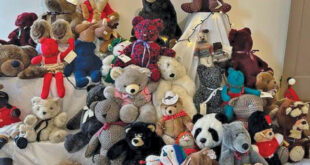Dance of life
By Dawne Belloise
Sasha Chudacoff walks with the grace and poise of one who has studied every aspect of movement, allowing her body to interpret the everyday music of the earth turning in both its simplicity and complexity.
It’s the chosen path of a dedicated dancer and Sasha has danced that course since she was three years old. She was raised with song and dance. Her father was a professional musician, composer and producer, and her sister Sophia is a vocalist. Their home in Los Angeles was filled with musical instruments. Sasha’s mom was an interior designer and between both parents, the girls grew up with an artistic and liberal background.

Sasha remembers creative time spent with her father and sister. “Dad would be improvising on piano, and Sophia and I would dress up in costume, lots of scarves, whatever I could find in mom’s closet but always very feminine things that had movement to them. Dad would tell stories while playing piano and we’d enact them. He’d tell a story of a little seed growing in the ground and the rains coming, then the sun appearing, a sprout making its way through the earth until it developed into a beautiful flower and the music would crescendo and we sisters would be running circles in the living room, scarves flying through the air. Generally the story would end with the flower going back to sleep and we’d return to a little seed like position on the ground.” She smiles with the memory.
When Sasha was 12, her family moved to Tennessee, just south of Nashville. For an open-minded California girl, it was culture shock and she found the transition difficult. Her parents wanted the girls to have more space so they moved to the small countryside town of Franklin, a bible belt of conservative Christianity, and being half Jewish, or as Sasha describes herself, a cultural Jew, just added to the alienation.
“I was old enough to understand what was going on, all the blatant racism. It was shocking,” Sasha recalls, citing the common and unfortunate use of derogatory terms.
Her parents decided that public schools in Franklin were out of the question, so Sasha and her sister were sent to a private all-girls school, which turned out to be, in Sasha’s words, “Quite oppressive. I had to work really hard at academics but I don’t think I learned a thing while I was there except how to be with people who were quite different from me.”
In a serendipitous stroke of fortune, a woman who was trained in modern dance opened a studio close to their home, the Franklin School of Performing Arts.
Sasha thinks, “It’s very odd that she opened a studio in such a conservative area but I’m very grateful she was there. I started training in ninth grade. Her program was unique. We were required to do ballet, modern technique, and jazz. We had our own student choreography showcase every year, which was quite progressive for a traditional dance studio, so I learned to choreograph at an early age.”
Sasha adds, “All children know how to make dance but they’re not always given the opportunity to do so.” For Sasha, it felt like a lot of juggling through high school between her academic studies and the discipline of dance. She graduated from high school in 2000 and essentially wasted no time in bolting back to the West Coast.
“All I knew was that I wanted to be in Northern California, and I got accepted into the University of California at Santa Cruz. I was ready for just a good ol’ liberal arts education,” she says, and at the time, she was burned out on dance.
“I just wanted to go smoke pot and be with boys by the ocean,” she laughs. “But what ended up happening is that I did continue to dance through college, but it was just for fun. I became captivated by Angela Davis, a professor of feminist studies and the history of consciousness and I ended up with a double major in feminine studies and community studies,” the latter, she explains, is basically a study of social change movements and activism.
“I chose to do an internship in San Francisco, working for an amazing organization called the Center for Young Women’s Development. We worked with young women who were in the justice system’s juvenile hall. The organization was started by women who had had experiences of being in juvenile hall themselves. My part of the program was to bring dance, hip hop, drumming and yoga to the girls’ unit of the home. I’d mainly go in and find out what their stories were then facilitate programming for their interests.” Sasha graduated with a B.A. with honors in her double major.
Although she’s always followed passion and interest as her guide, with no specific plan, Sasha moved to San Francisco and became a teacher in a preschool, earning an associates degree in childhood development studies through San Francisco City College while she worked. She had previously worked as a teacher’s assistant at the Child Development Center, which was a preschool for all the university employees’ kids.
The entire time Sasha was teaching, she was taking dance classes in the Mission District, where some of the best hip hop instructors were. “I was fascinated with hip hop. I was at Dance Mission Theatre, performing with them in a little hip hop group. The theatre was a studio-performance center and the school was the heart of cultural dance in San Francisco.”
Sasha describes dance styles they encompassed that some people may not be familiar with, such as “Voguing, whacking, popping and locking, and Afro samba and salsa. Voguing and whacking came out of the queer community as a posing style of dance based on runway models and silver screen stars of the 40s. Popping and locking is where you send a wave through your body and lock it down in a certain body part.”
She was involved with cutting-edge progressive dance and wanted to take her education to a more expansive level so in 2009 Sasha enrolled in a graduate study program at Naropa Institute in Boulder for somatic psychology-dance movement therapy.
She explains, “It’s the study of how movement can be healing in a ‘scientifically recognized’ way. I was there for a year and I loved it but in the end, it was too expensive and I had decided that I didn’t want to be a therapist. Essentially, that’s what I would have had to do to pay back all my loans, but I’m so grateful for my time there. It allowed me to be a unique and attuned movement dance facilitator.”
At Naropa Sasha became interested in Butoh, a form of Japanese dance, with its lineage from Kabuki theatre, performed traditionally in all-white body paint. Sasha notes, “It was developed during WWII as a needed cultural rebellion at the time to express pain and suffering through the body. It was a rebellion of the westernization of Japan. The actual word, Butoh, means dance of darkness. I became completely obsessed with it.” When Butoh was developed it was done mostly underground in more secretive spaces, in the nude but in completely white body paint. She sought out teachers in Boulder and ended up dancing with a small Butoh company called Syzygy. “We did site-specific dances in the outside environment.”
At some point in 2010, Sasha felt the need to return to San Francisco and landed a job in the Berkeley public school system as a dance specialist. “It basically meant I got to go to all the classes in the preschool and elementary and teach dance in the classrooms because we didn’t have a dance studio. We got real creative. I had a little boombox.”
San Fran was not a cheap city to live in and Sasha always had multiple jobs to make ends meet, so she was also a nanny. She was working during the day and back in the dance scene taking classes at night. “I became really interested in physically integrated dance, studying and taking classes with a mixed abilities dance class, meaning, the dancers were both fully abled and disabled, some were in wheelchairs or different apparatuses. I was there for only a year but I was eating up more and more dance.”
During Burning Man in 2011, she reconnected with a former boyfriend, Carson West, who was living in Crested Butte, and they fell back in love. Upon returning to Berkeley, Sasha discovered she no longer had a job because they had cut the funding for her position—in fact, all the arts funding was being cut across the state. Carson suggested she come try Crested Butte for the winter.
“So I agreed and ended up loving it and stayed. I was ready to give up some of the dance in my life. I didn’t know there was an interest in movement and dance here and that there was a small dance community already existing. When I saw the Pump Room I was like, wow, I can make this work—there’s a space already here. I was so creatively inspired by being in this environment, because of my Butoh background I’m not afraid to dance on the land, I don’t need a stage. I was very inspired by the Gronk and all the mining structures and wanted to dance with them and the land here, to let its story be told through the body. And I’m still just fascinated by the rich mining history, the pain of the land and the dark beauty of the land.”
Last summer was a dream come true for Sasha as she invited her Butoh teacher from her Boulder days to come to Crested Butte and teach a weekend workshop with the community. It culminated in a public offering at the Gronk.
“We began opening a new creative chapter of diving into the history of the land here through dance. We spent a whole day at the Gronk doing body research and different dance exploration that allowed the place to tell its story, opening to different energies. I called it the Mine Project.”
Currently, Sasha teaches for the Crested Butte School of Dance and the Crested Butte Dance Collective, to a diverse age group with wide range of styles, “I teach parent-child classes and kindergarten through adults. I teach hip hop, jazz, and ballet. I also teach aerial dance, another passion.”
If a group requests it, Sasha will teach physically integrated dance with Adaptive Sports Center sometimes. And she still does nannying locally as well as administrative work for the dance organizations. This year, she directed the sold-out and always-popular Move the Butte.
When she’s not dancing, Sasha loves to bike, although she qualifies that it’s “easy mountain biking. I like to walk and hike and occasionally Nordic ski. All my extra money goes to further my dance education outside of the valley. I go back to San Francisco, Boulder and the East Coast, depending on where my teachers are. I do miss being in a place of challenge, artistically and creatively, in the art world, but my nervous system loves and is at peace in Crested Butte. And there are many progressive and creative thinkers here that I’m constantly in awe of. I do believe Crested Butte is a place to grow artistically and the community has accepted me with open arms so far. Between the community, the exquisite beauty, and my loving relationship, I genuinely enjoy my lifestyle here that I couldn’t have in the urban world.”
 The Crested Butte News Serving the Gunnison Valley since 1999
The Crested Butte News Serving the Gunnison Valley since 1999



